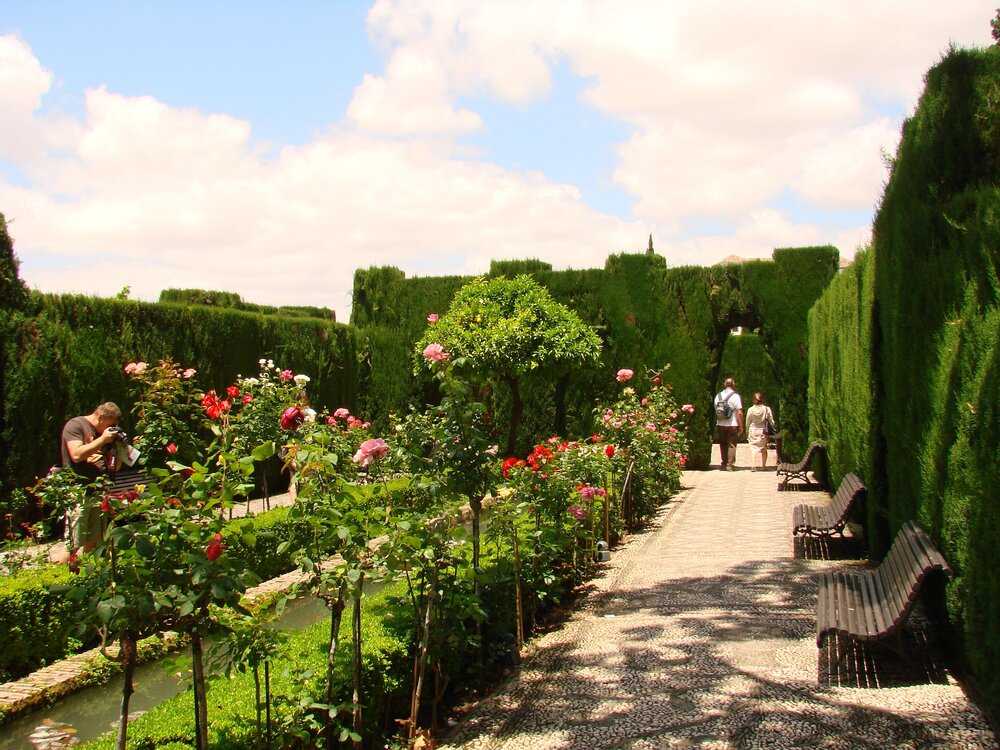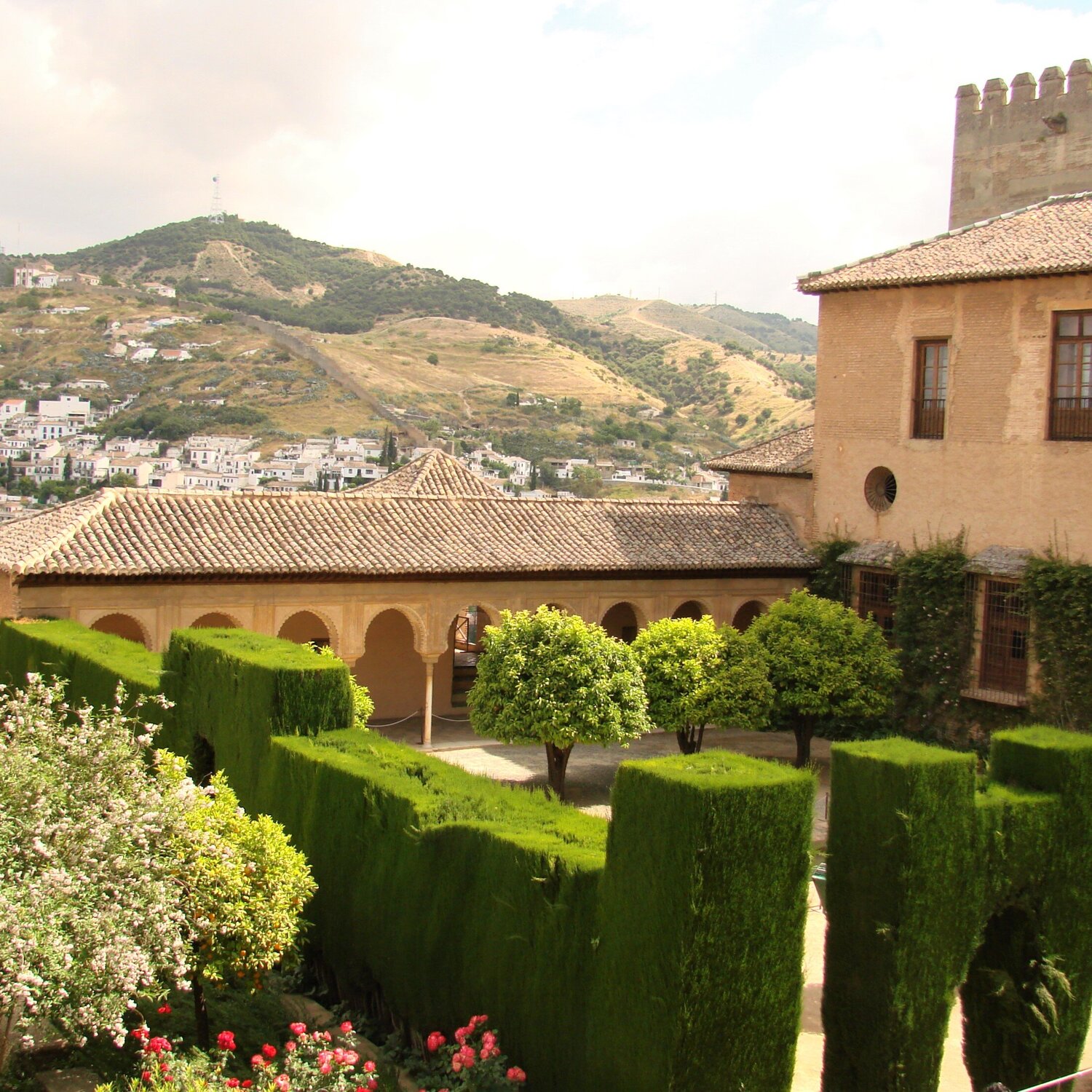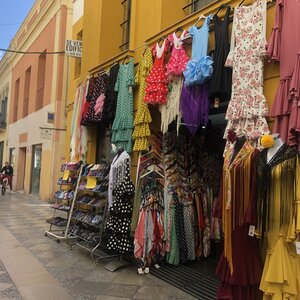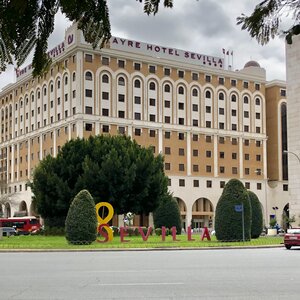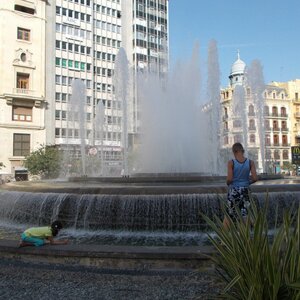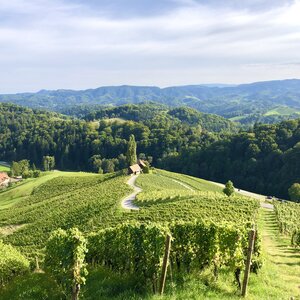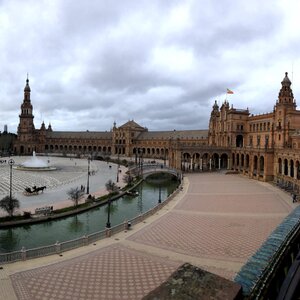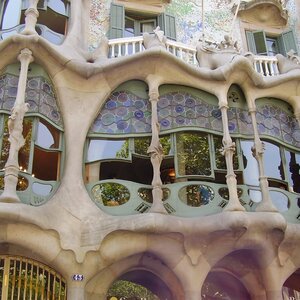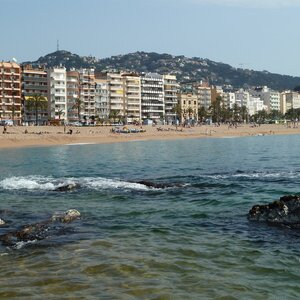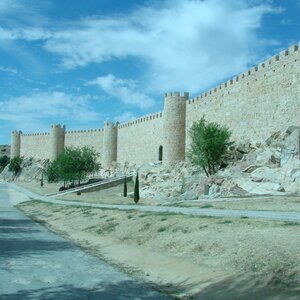In 1492 Andalusia returned under the rule of the Catholic kings, the Arabs left, but left behind a legacy that has no analogues anywhere else in the world.
In the mix of Muslim and Christian cultures in Andalusia, a unique, unlike anything else, the Mudejar style emerged: it is Moorish architecture mixed and melted with Gothic and early Renaissance. The Arabs brought to Spain the art of ceramics (azulejos) and wooden carvings.
There are many Mudejar palaces throughout Spain, but the Alhambra claims to be the best example of Moorish architecture in Europe. This huge palace and park ensemble is one of the most visited sights in Spain. Books have been written about the Alhambra, movies have been filmed, poems and music have been dedicated to it. More than two million tourists from all over the world visit it every year.
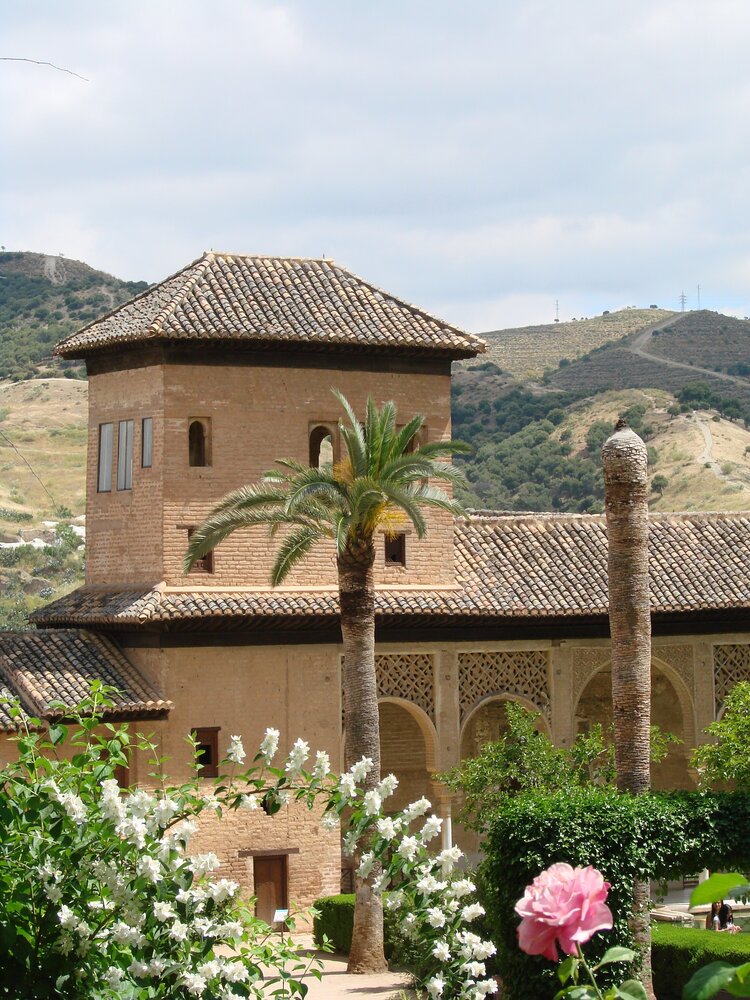
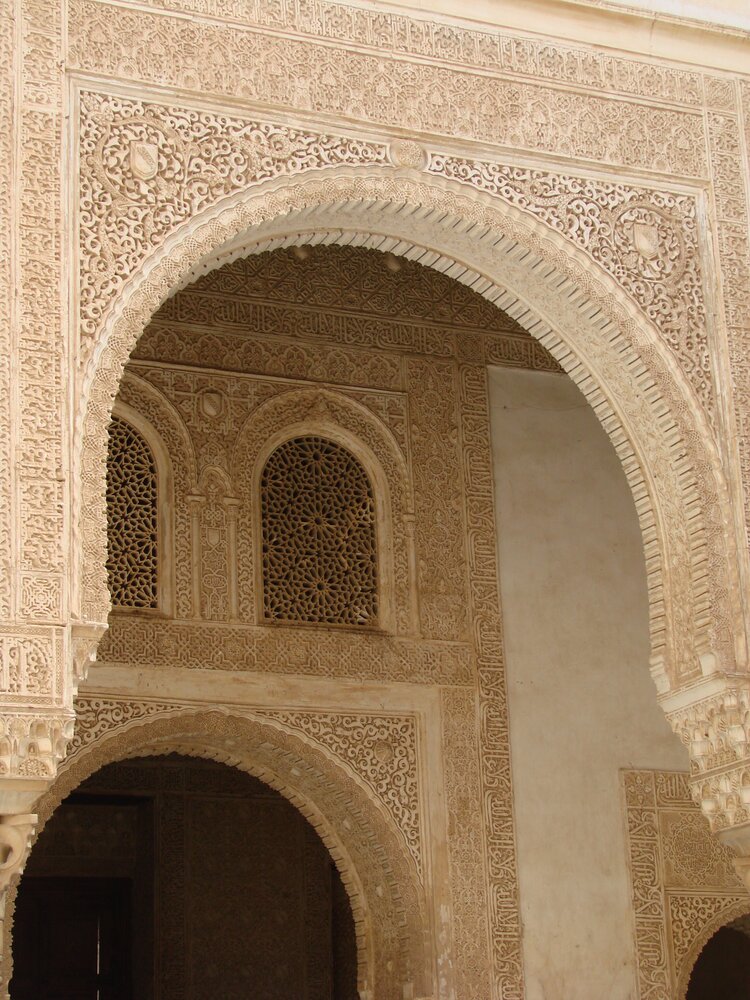
The Alhambra is located on a rocky hill, one kilometer from the city of Granada. In the VIII century Arab rulers, having conquered the south of Spain, laid the first fortress on the hill. Alhambra was built in XIII — XV centuries, when Granada was the capital of the emirate of the Nasrid dynasty. The Alhambra became a fort, a palace and a small town at the same time. Mosques, houses, gardens, warehouses and palaces of emirs appeared behind its fortress walls.
At the end of the XV century Granada returned to Catholic Spain, and the Alhambra became the royal residence until the XVIII century. During this time, a Christian church replaced the mosque and construction began on the Charles V Palace, which is now part of the Alhambra but stands a little apart.
Alhambra translates from Arabic as «red castle». The complex is called so either because of the color of terracotta clay from which the palaces were built, or because the construction of the complex was illuminated by the red flame of torches. Historians do not know the exact version, but after the return of Granada in the possession of Spain to rename the Alhambra did not begin. The Spanish elite liked the Mudejar style, so the luxurious buildings and gardens were also preserved.
The modern buildings of the Alhambra are restored: the complex was badly damaged in the 19th century by Napoleon’s army and by an earthquake. The Alhambra has been a national monument of Spain since 1870 and a UNESCO World Heritage Site since 1984.
Set aside at least three hours to see the Alhambra and stock up on sandwiches: the complex is made up of several large parts.
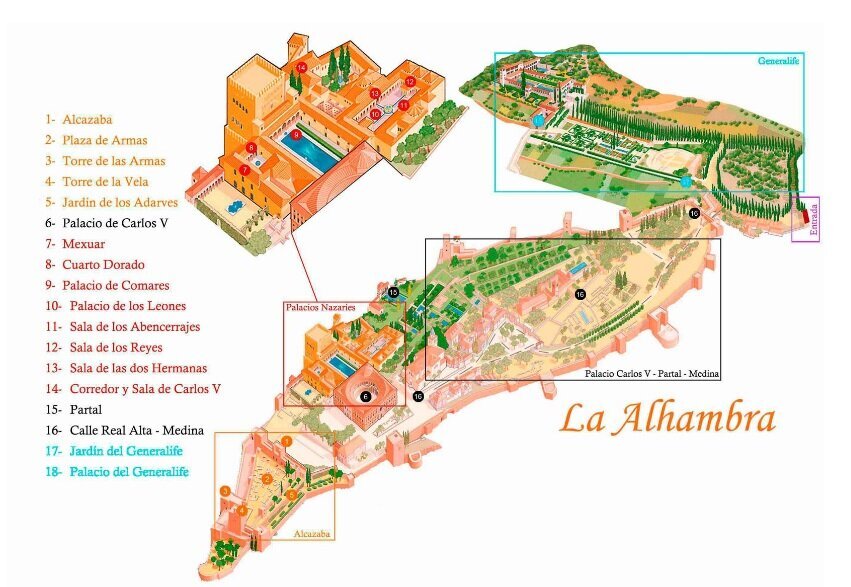
Alcazaba Fortress (Alcazaba)
The ancient defensive part of the Alhambra is the Alcazaba Fortress. It served as a fortress under the Muslims, and with the arrival of the Christians it became a state prison.
The Alcazaba was home to an elite garrison that served the Sultan and guarded the city. Today, the remains of the houses where the military once lived can be seen in Alcazaba’s Armory Square.
There are more than 20 towers along the perimeter of the fortress. The most interesting of them can be visited:
- Round tower (Torre del Cubo) from the late 16th century. The tower has an observation deck overlooking the valley and the Albaycin, a residential area of Granada.
- The Watch Tower (Torre de la Vela) is 27 meters high, with four floors. It is considered the highest tower in the Alhambra.
- The Torre del Homenaje is a six-story structure that housed Muslim rulers while the Alhambra palace was under construction.
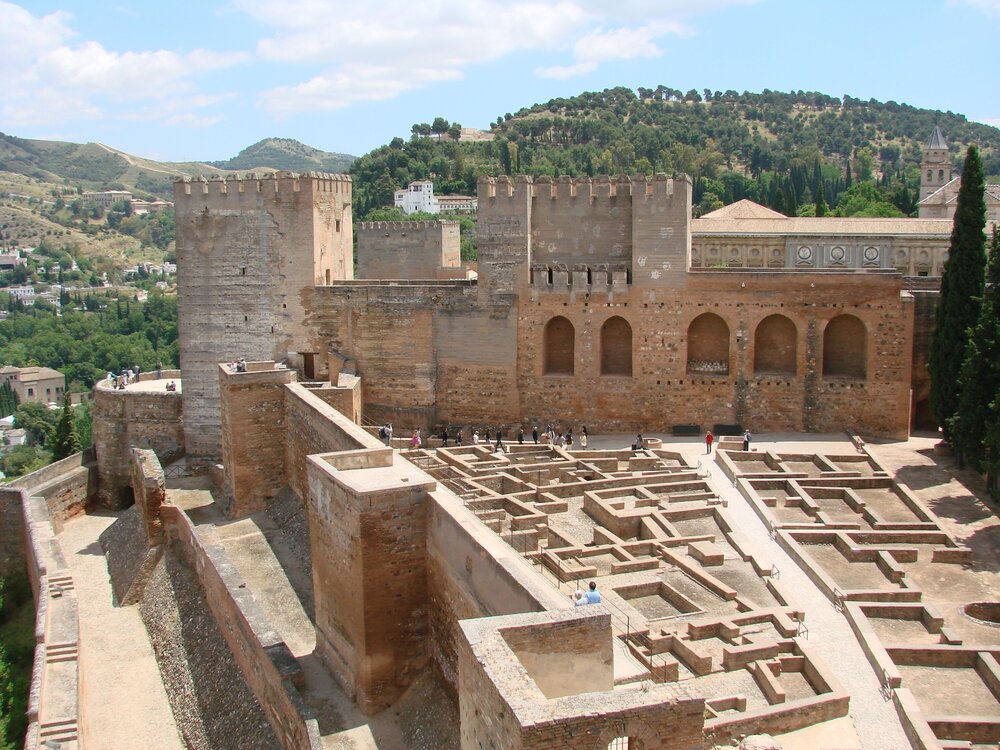
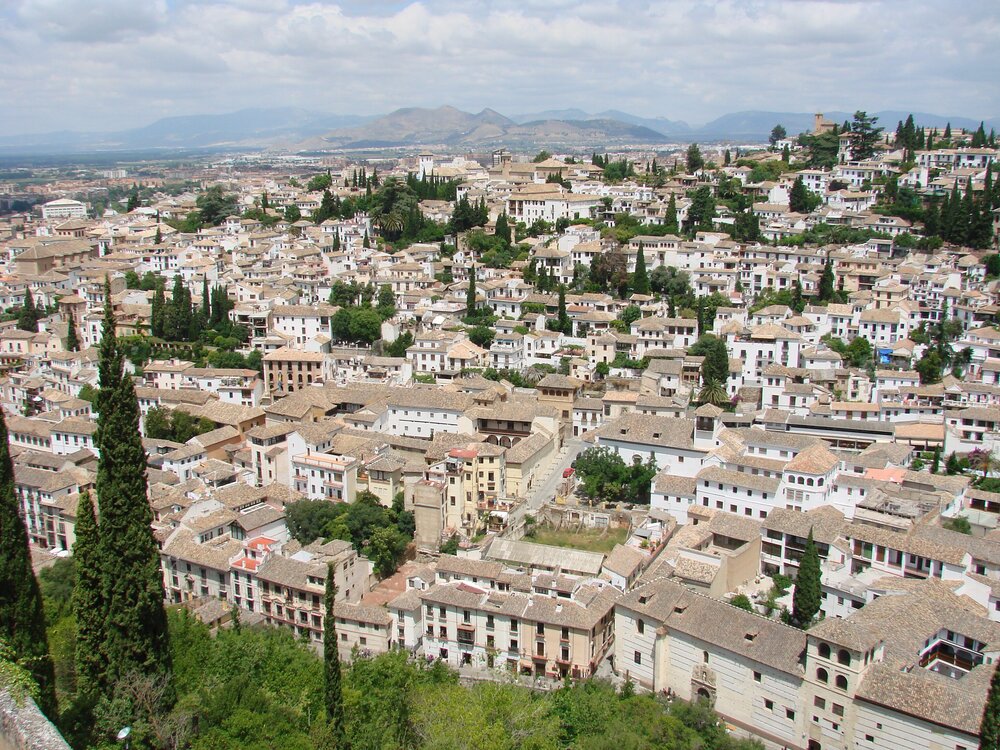
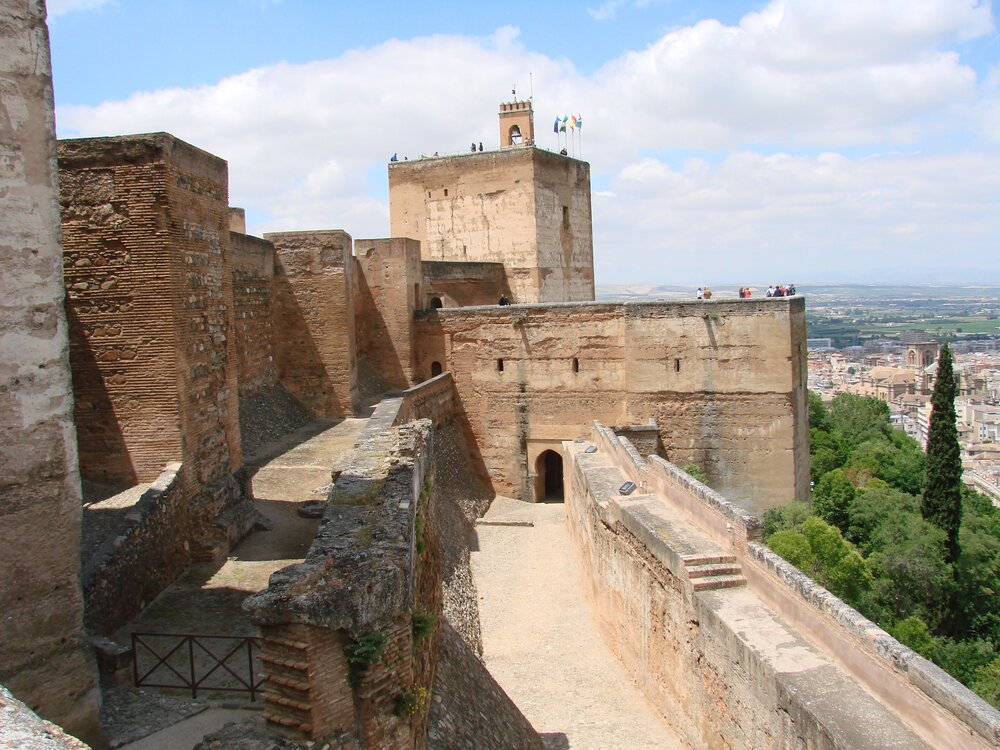
Nasrid Palaces (Palacios Nazaríes)
The most famous part of the Alhambra, its most impressive structures are the Nasrid palaces. From the outside, it is difficult to imagine the beauty of the Muslim palaces: all the most interesting things are inside and are revealed only to the guests.
The Nasrid palaces began to be built in the XIII century, but the buildings that have survived to this day date back to the XIV century. The palace complex is divided into three parts: the Palace of Comares, the Palace of Lions and Meshuar. The Arabian luxurious palaces are united by picturesque courtyards with fountains and vegetation.
A limited number of tourists can enter the palaces daily. Each ticket has a specific time for visiting — the item «Horario Palacios Nazaries». Approach the entrance to the palaces of Nasridov should be in advance to take the queue and pass in time. If you are late, you will not be allowed into the palaces. One hour is given for inspection, but those who are late will not be kicked out.
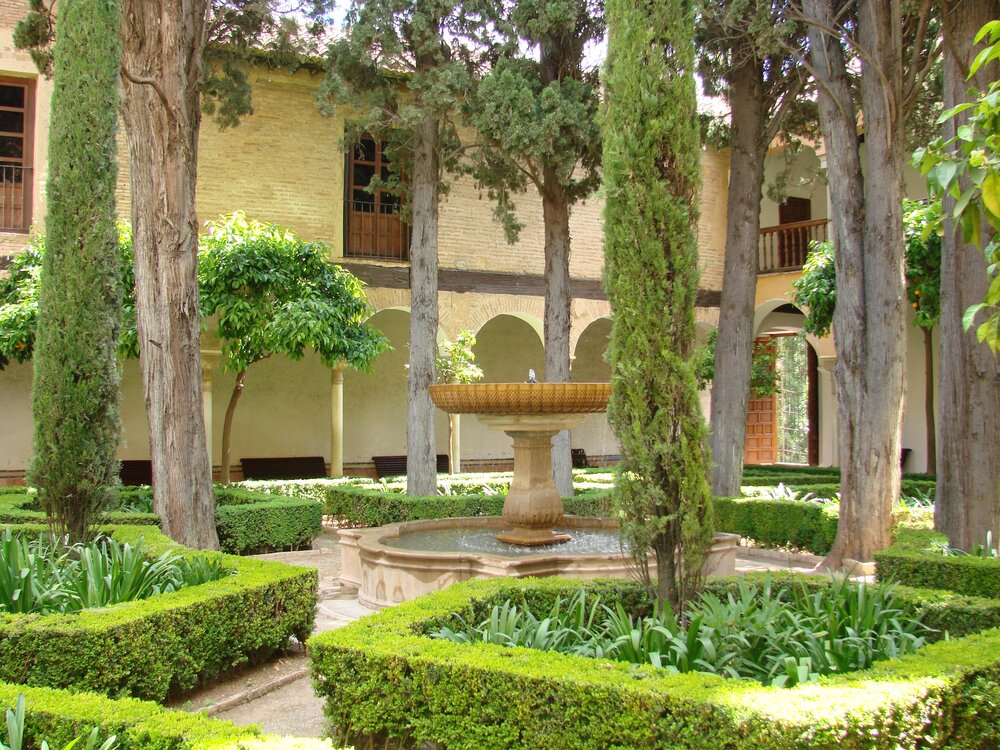

Palacio de Comares (Comares Palace)
The most beautiful room, according to the founder’s idea, is the Comares Palace, the official residence of the Emirs of Granada. The palace was to amaze guests with its sophistication, so no expense was spared in its decoration. The fine Arabic carvings adorning the walls of the palace can be admired for hours.
The center of the palace is the Myrtle Court (Patio de los Arrayanes), where there is a marble pond with goldfish, enclosed by a hedge of myrtle.
The highest tower of the complex, Comares, stands 45 meters above the Myrtle Court. It houses the Hall of Ambassadors (Salón de Embajadores), the palace’s throne room, majestic and ornate, with an 18-meter high cedar wood ceiling. The windows in the hall are designed so that sunlight illuminates the throne. The tile floor, walls and arches are decorated with Muslim moldings and carvings of prayers and verses. Legend has it that in this hall, Columbus convinced the king and queen to organize an expedition to India.

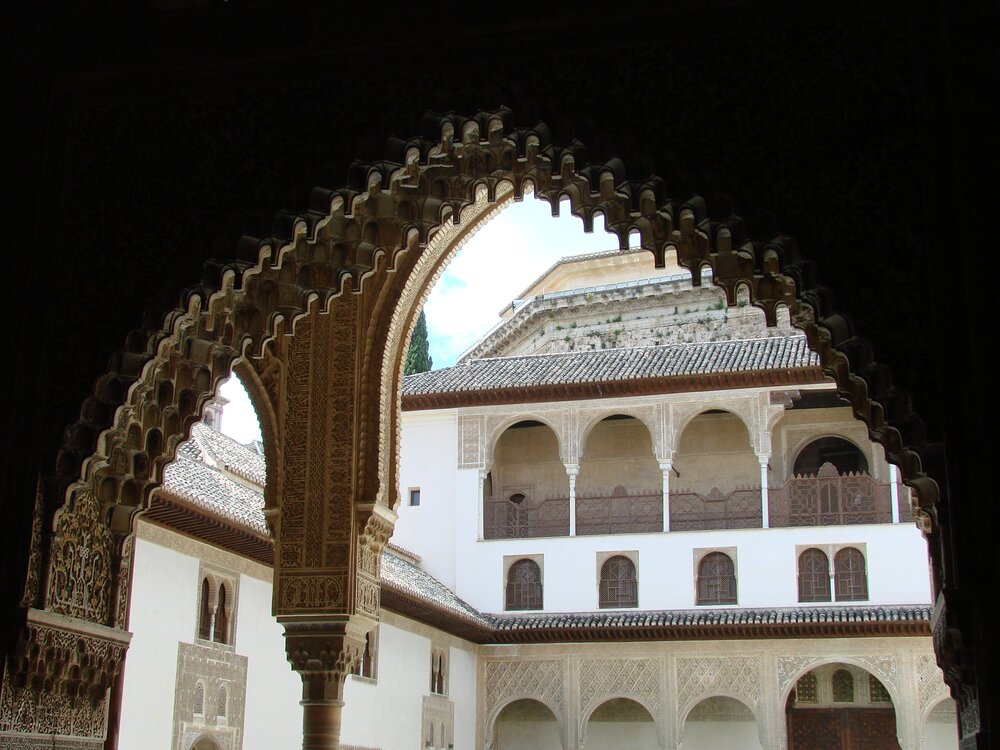
Mexuar.
Here the Muslim rulers of Granada held official receptions, important meetings and courts. The Meshuar is the oldest and simplest part of the Alhambra. Only a small part of the former buildings remains, which is now called the Meshuar.
Even this utilitarian room draws the eye with its exquisite Arabic stone carvings.

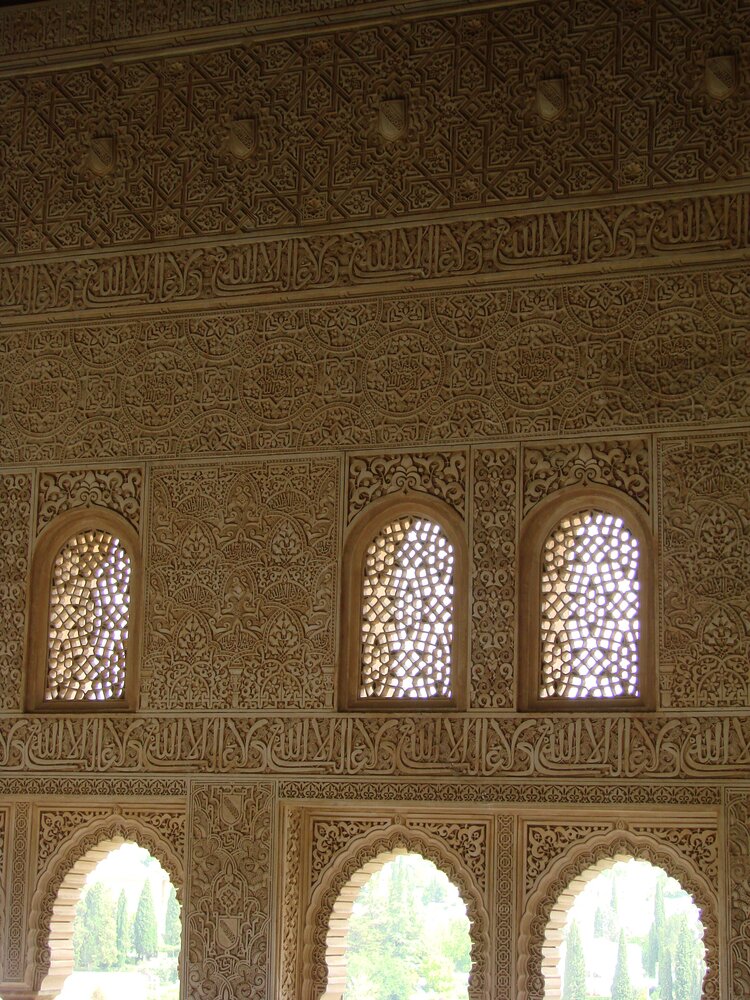
Palace of Lions (Palacio de los Leones)
This palace was the harem, the private quarters of the sultan and his family, where outsiders were forbidden to enter. Now we can see the palace from the inside, but during the Arab rule it was a closed part of the royal palace.
The central entrance to the palace, the Patio de los Leones, is one of the most famous and photographed places in the entire Alhambra. The courtyard is surrounded by 124 columns and in the center is a fountain with 12 marble lions. The entire courtyard is decorated with dazzling white marble.
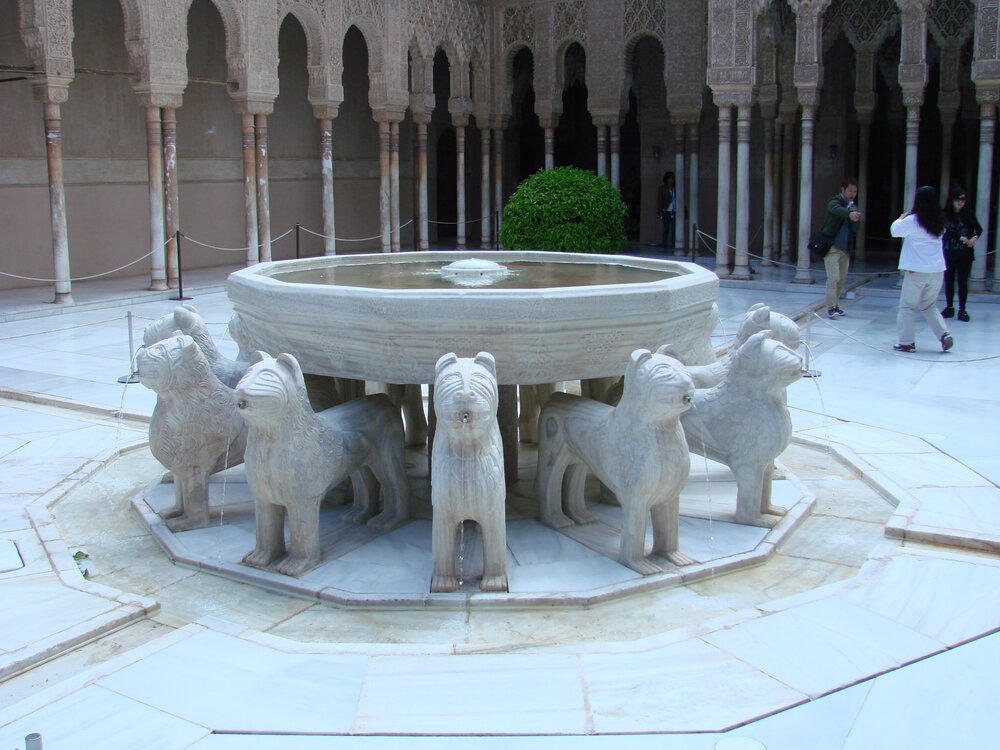
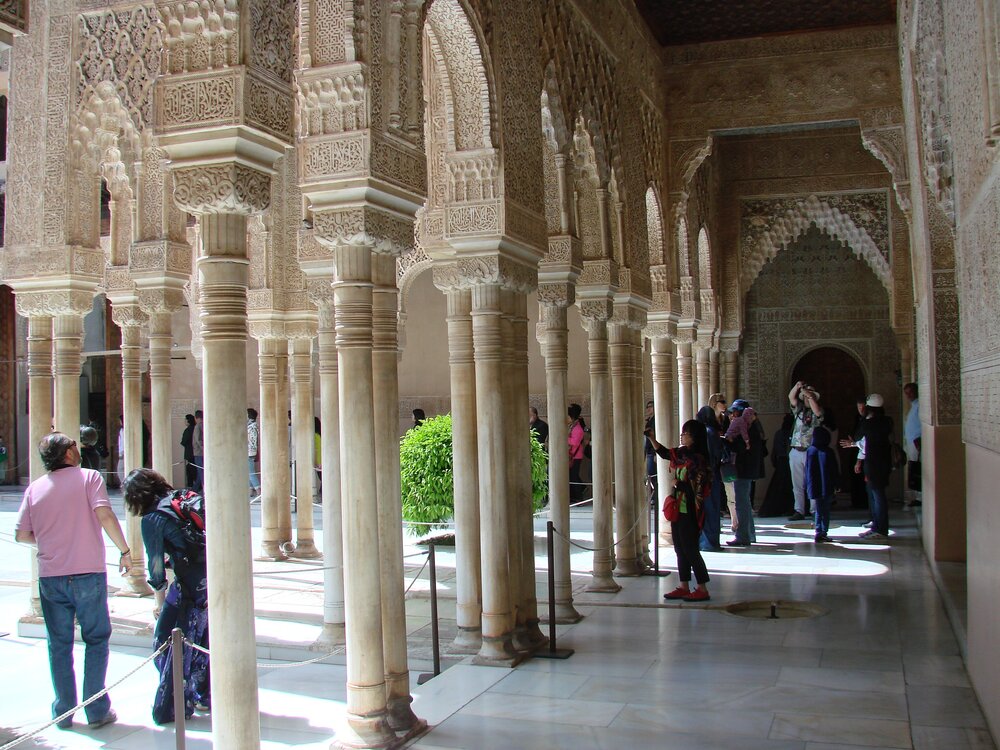
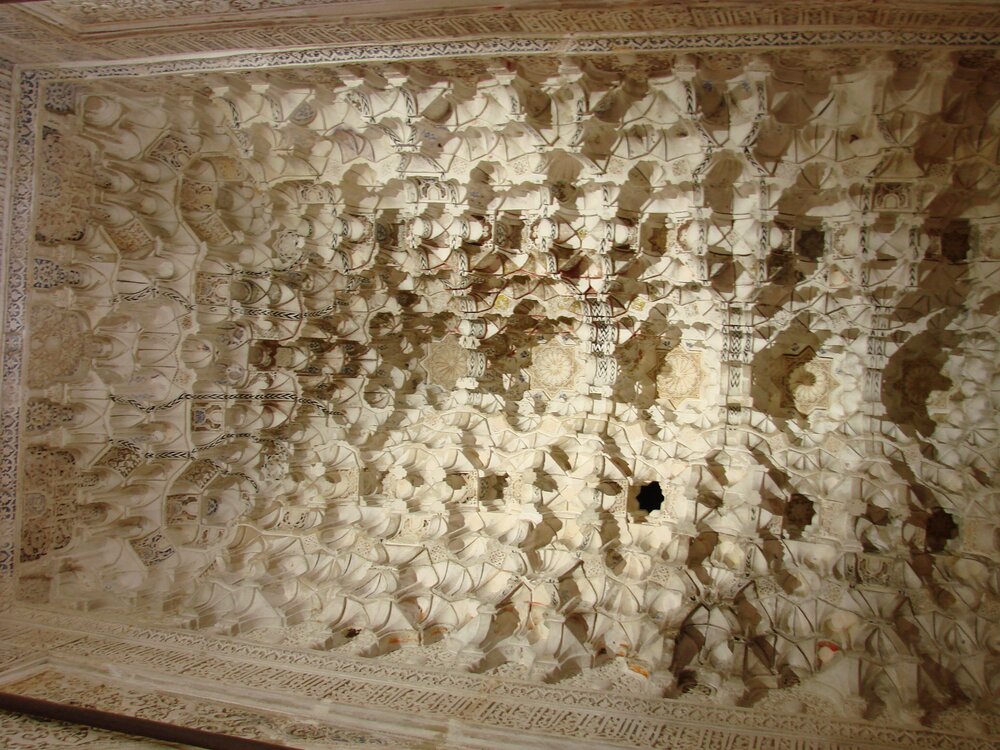
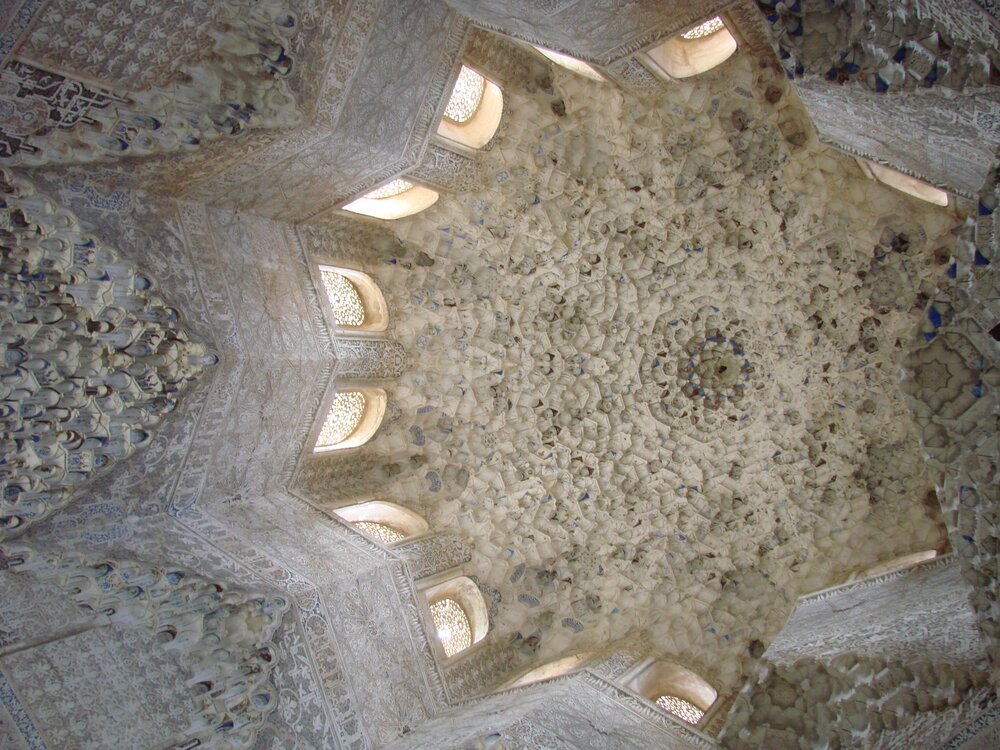
Interesting halls of the Lions Palace:
- The Hall of Stalactites (Sala de los Mocárabes) has an unusual vaulted ceiling resembling stalactites.
- The Sala de los Abencerrajes (Hall of the Abencerrachs) has a star-shaped dome decorated with stalactites. According to legend, all representatives of the noble Moorish family of Abencerrajes were executed here, and the rust in the marble bowl in the middle of the hall is the stains of their blood. The whole family was executed at the same time not only for the connection of one of the Abenserrakhs with the sultan’s wife, or for participation in the coup — historians differ in versions.
- The Hall of the Kings (Sala de los Reyes) has a ceiling painting depicting the first ten rulers of the Nasrid dynasty that ruled Granada from 1230.
- The Hall of the Two Sisters (Sala de las Dos Hermanas) was the central room of the sultan’s wives' quarters. The mother of the last Emir of Granada also lived here. The name is connected with two large identical slabs of marble on the floor. In the center of the room there is a fountain and on top of it there is an octagonal Arabian dome, which looks like a huge carved flower in the play of natural light.
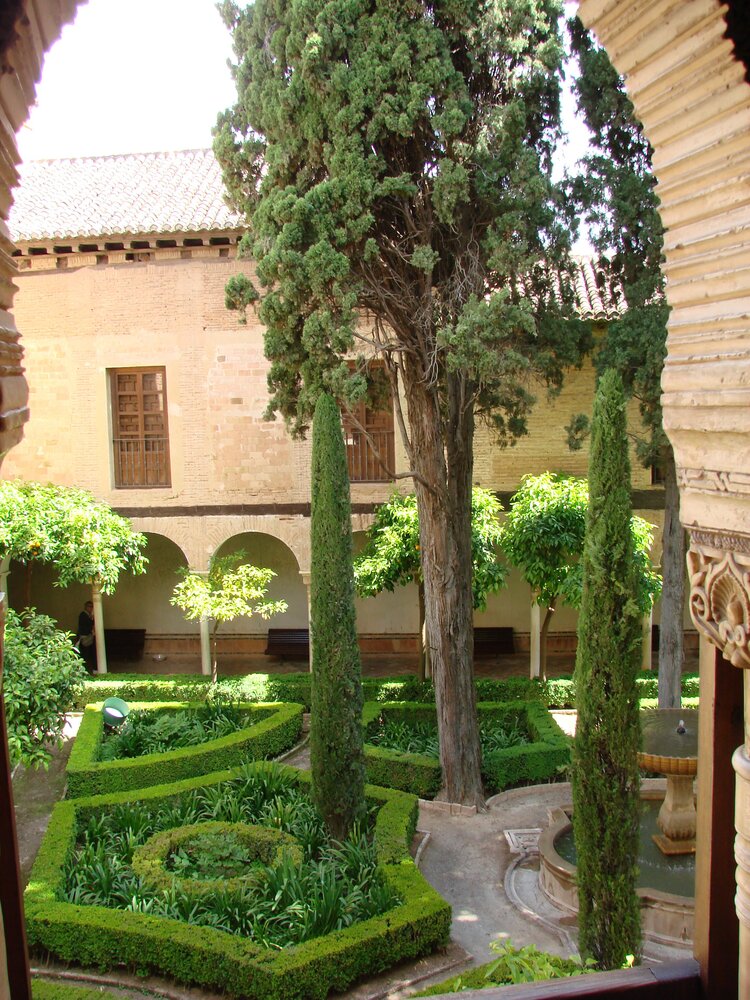
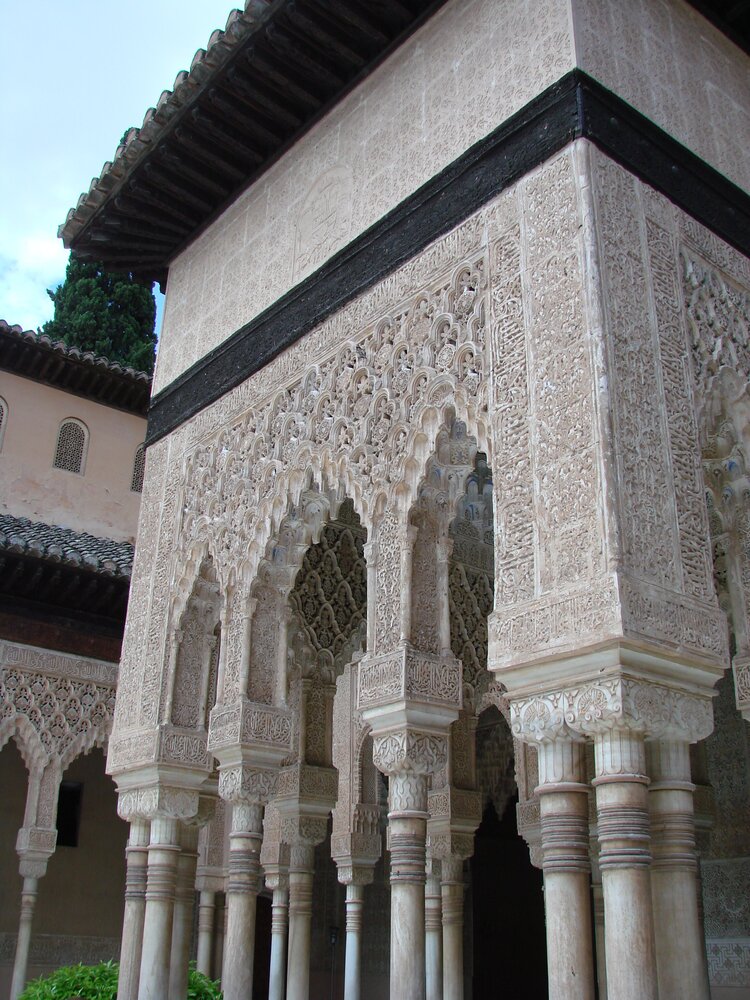
Carlos V Palace (Palacio de Carlos V)
In 1527, after Granada was returned to the Spanish crown, the construction of the summer residence of King Carlos V of Spain began near the Moorish Nasrid Palace. This construction is a symbol of the triumph of Christianity over Islam, and it does not fit into the general Moorish style of the Alhambra. The erection of the palace lasted several centuries and was completed only in the second half of the XX century. The reason for the long construction is banal — interruptions in financing.
The palace is built in Roman style, has a square shape, and inside there is a small circular courtyard with a diameter of 30 meters.
The first floor of the palace is occupied by theAlhambra Museum (Museo Arqueológico de la Alhambra). Artifacts found during excavations are exhibited here. Entrance to the museum is free of charge.
The second floor of the palace is occupied by theGranada Museum of Fine Arts(Museo de Bellas Artes de Granada). Entrance is 1.5 €.
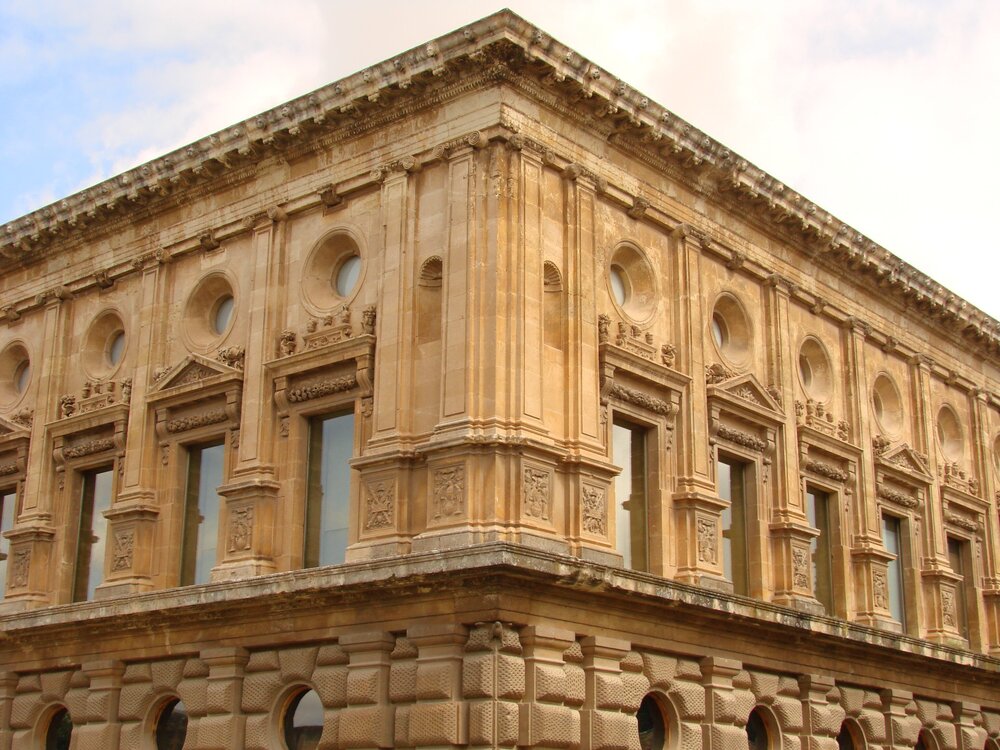
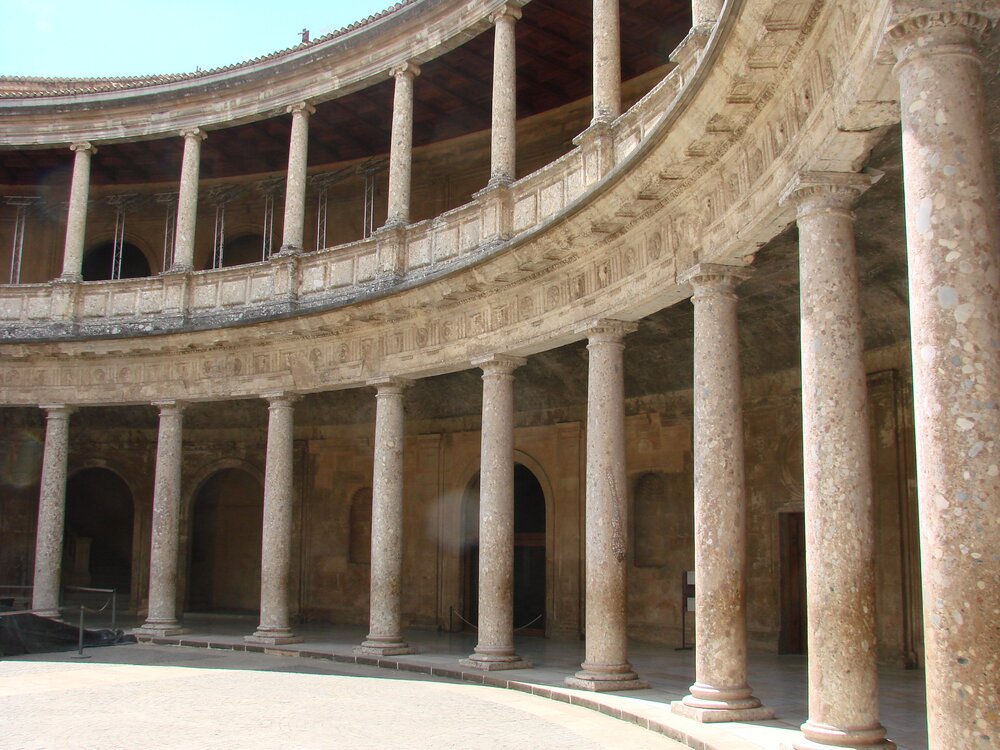
Palacio del Generalife (Herenalife Palace)
The Generalife is located outside the eastern walls of the Alhambra. This palace was built for the recreation of the Sultans of Granada between the 13th and 14th centuries.
The Generalife is the simplest and most modest palace of the Alhambra, with interesting courtyards, ancient Arabian gardens and small fountains. In 1952, an amphitheater was built in front of the Generalife for the Granada International Festival of Music and Dance.
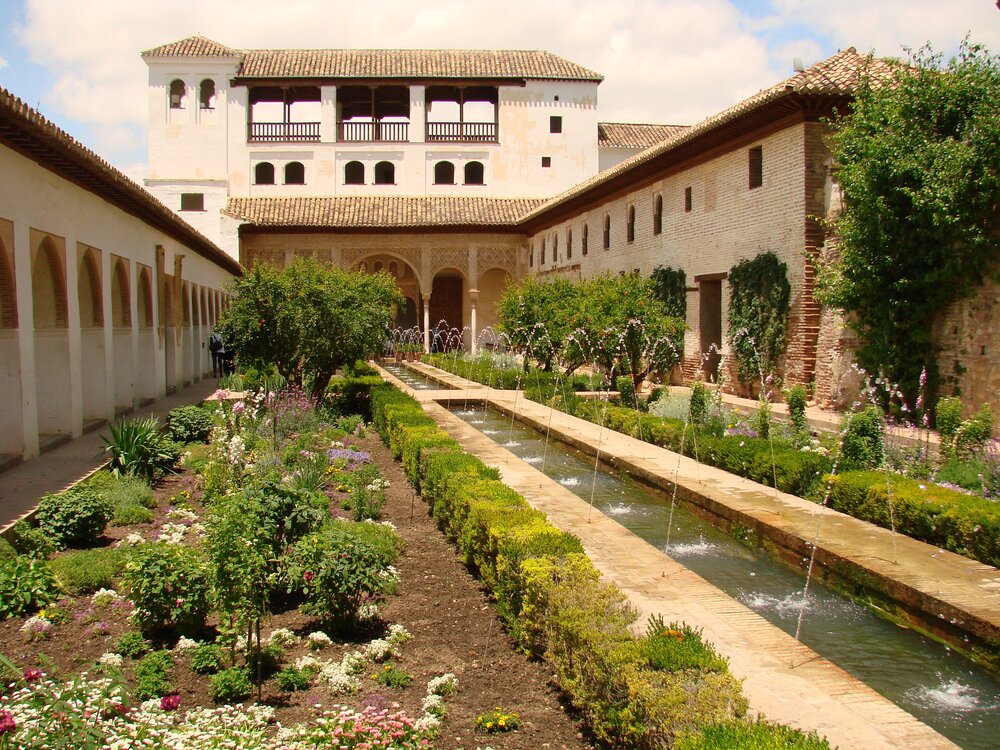
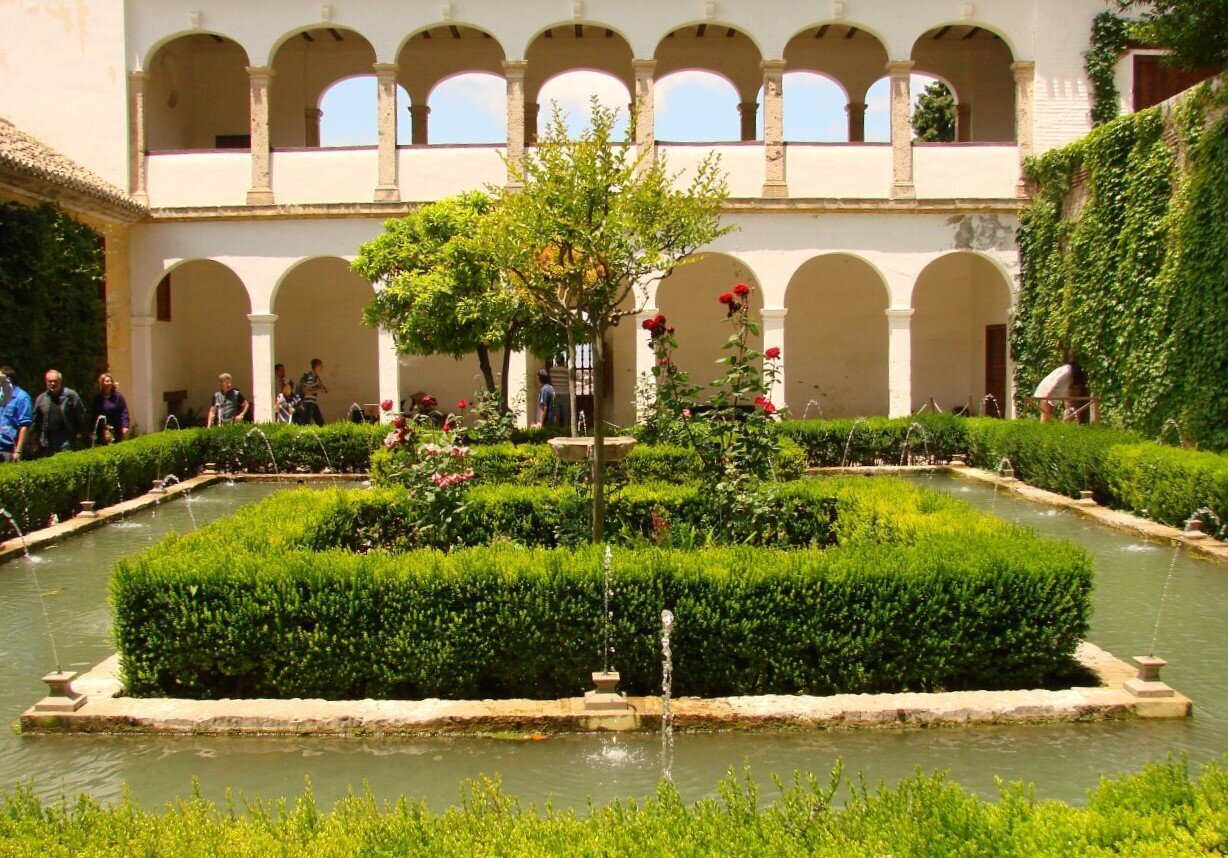
Alhambra Gardens (Jardines de la Alhambra)
In the Alhambra you can find many gardens of different historical eras: from medieval Islamic to modern ones opened in the XXI century. Some of them are in the courtyards of the palaces, some are independent elements of the complex.
For the Moorish emirs, gardens were the embodiment of paradise on Earth, so their construction was approached in a special way. The Arabian gardens of the Alhambra are characterized by many small fountains, water cascades, canals and reservoirs. Orange and pomegranate trees, cypresses, persimmons and countless varieties of roses grow in the gardens.
The Generalife Palace is surrounded by a garden that is considered the oldest working garden since the beginning of Moorish rule in Spain. The Generalife Gardens are a UNESCO World Heritage Site.
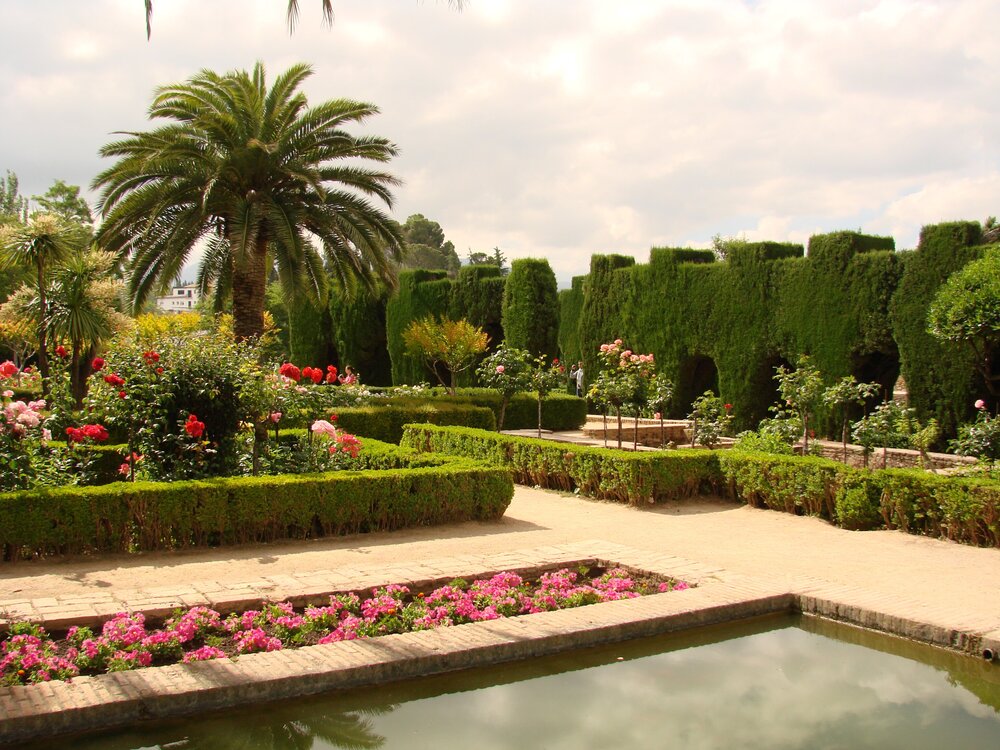

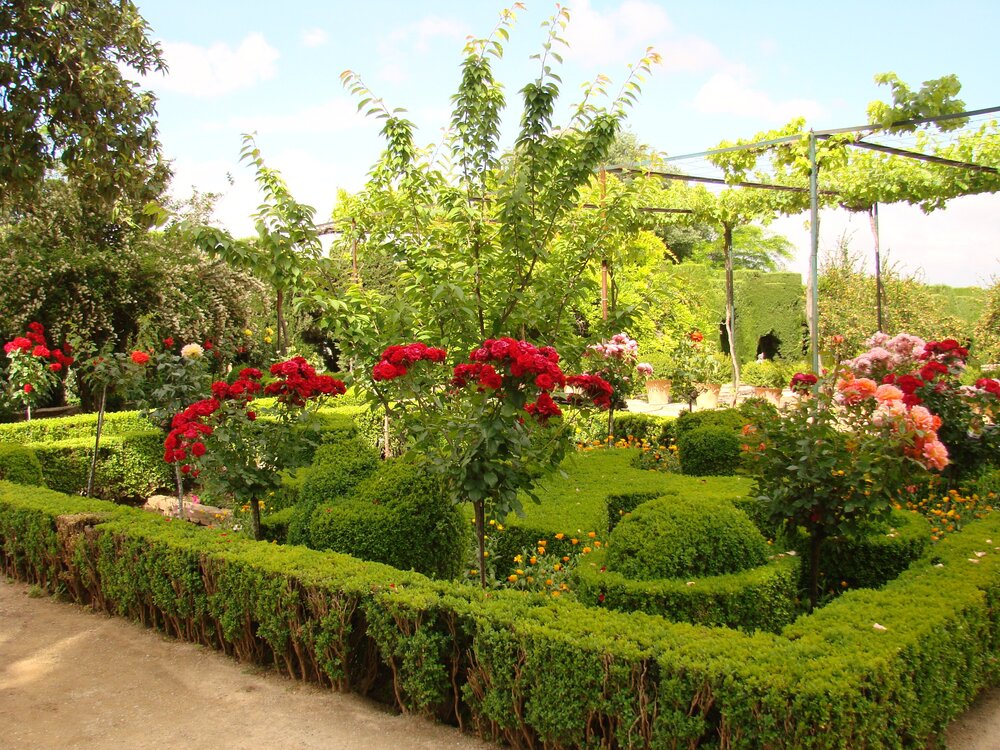
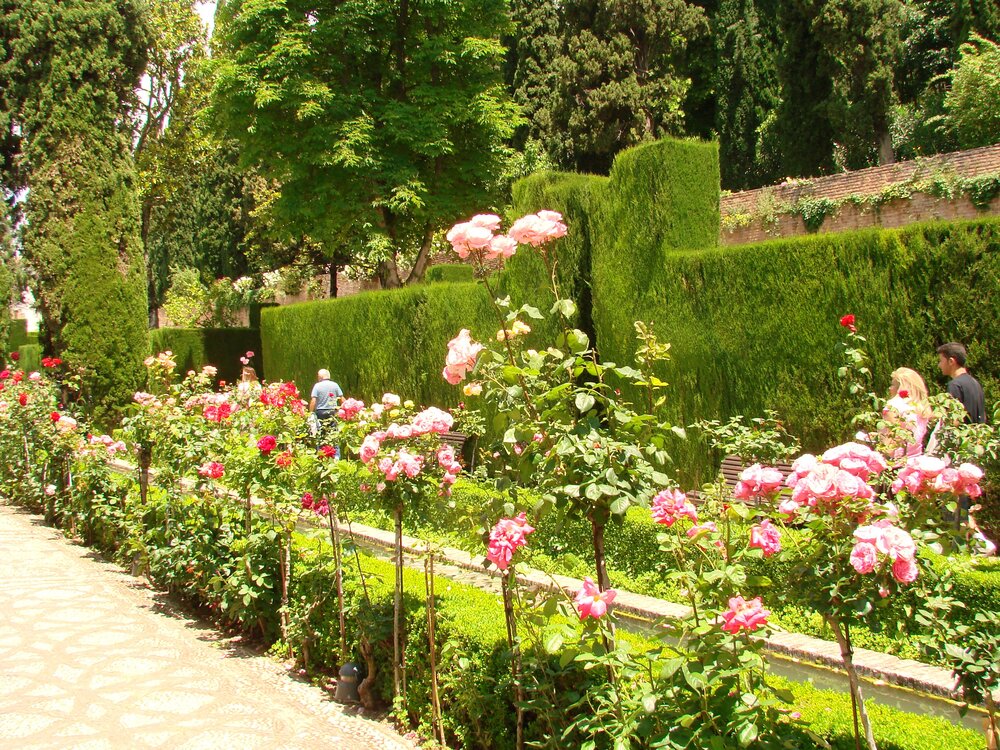
Organizing a visit to the Alhambra
The Alhambra can be visited during the day or in the evening. There is also a night visit, when the gardens and palaces are illuminated, but the time for the tour is limited and the sights are not fully open. Also at night you can not take photos with flash, so you can forget about beautiful photos in the Arabian interiors and gardens.
Alhambra Ensemble, Palacios Nazaríes, Generalife, Palacio de Carlos V:
- Day visits are daily, April 1 — October 14 from 8:30 a.m. to 8 p.m., October 15 — March 31 until 6 p.m.
- Overnight visits: from April 1 through October 14 — Tuesday through Saturday, 10:00 p.m. to 11:30 p.m. October 15 through March 31 — Friday and Saturday from 20:00 to 21:30.
Entrance fees to the Alhambra
There are several options for Alhambra tickets:
- Alhambra General» ticket to enter the main buildings of the Alhambra — the Alcazaba, the Nasrid Palaces, the Generalife and the Palace of Carlos v. The ticket costs 14 € for adults, children under 12 years old are free of charge.
- Day admission to all sites except the Nasrid palaces: 7 € — adults, children under 12 years old are free.
- Ticket «Visita Nocturna a Palacios Nazaríes» — night entrance to the Nasrid palaces: adults — 8 €, children under 12 years old are free.
- Ticket «Visita Nocturna a Jardines y Generalife» — night admission to the Generalife Gardens: adults 5 €, children under 12 years old are free.
- Combined ticket «Alhambra Experiencias», includes a night visit to the Nasrid palaces and the next day a day visit to the gardens, Generalife and Alcazaba: adults 14 €, children under 12 years old free admission.
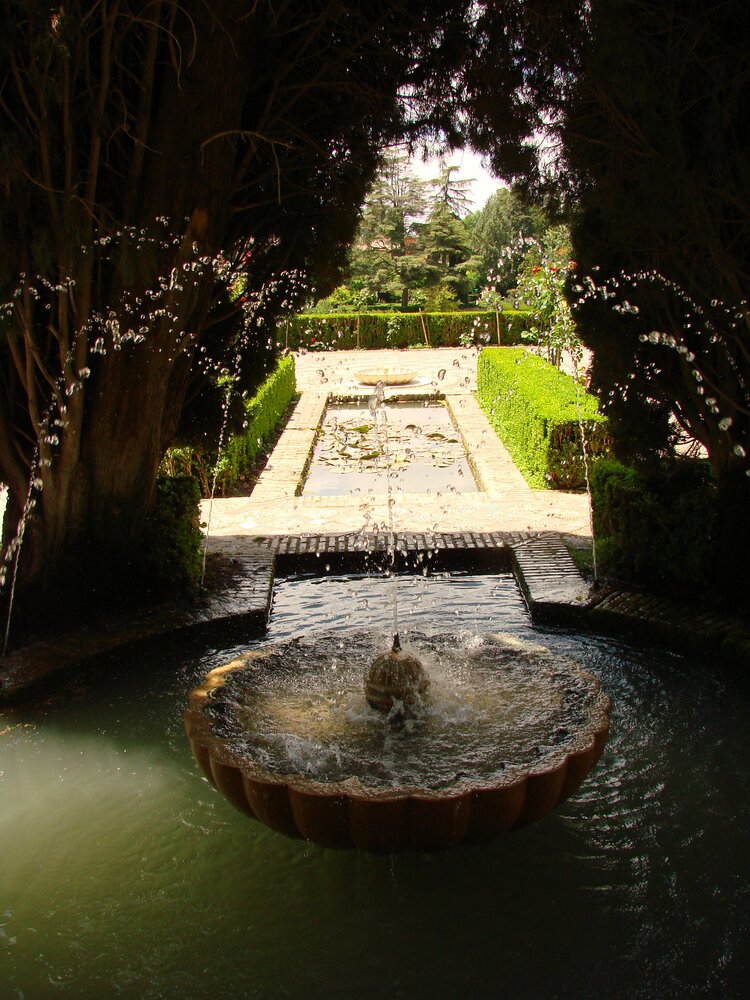
How to buy tickets to Alhambra
The Alhambra is one of the most difficult sights to see in Europe. Seeing the Nasrid palaces is as difficult as Leonardo da Vinci’s famous Last Supper fresco in Milan.
The daily number of visitors is strictly regulated and only a limited number of tourists are allowed into the Nasrid palaces. There are not enough tickets for everyone. I will tell you how to buy a ticket to the Alhambra.
On the site
The most budget-friendly and surest way to buy a ticket to the Moorish complex is to buy online at the official Alhambra website. The site commission is 2% of the ticket price.
Online purchase is possible no earlier than 3 months before the date of visit and no later than 2 hours in advance — if there are seats left.
Tickets to the Nasrid Palaces are bought out 2.5 — 3 months in advance. There is a very high probability that later they will not be available or a single ticket will be left. Therefore, you should plan your visit to the palaces in advance.
If you don’t plan to visit the Nasrid palaces, you can try to buy a ticket to the rest of the complex online a few days before your visit.
The ticket purchased online will need to be exchanged for a paper ticket at the Alhambra ticket office or terminal. Important: you can only use the terminal if you have the bank card used to pay for the ticket online.
In Granada travel agencies
Most of the tickets to the Alhambra are bought in advance by travel agencies organizing group tours. The cost of an organized tour is more expensive than an independent visit. But tickets can be found a few days before the visit.
If Alhambra doesn’t have tickets left for your dates, check out the group tour options on the website.
At the Alhambra ticket office
There is no pre-sale of tickets at the ticket offices of the complex. They are sold only on the day of the visit and only the number left after online sales. Therefore, it is not possible to buy a ticket to the Nasrid palaces through the ticket office. Only tickets to other parts of the complex, except for the palaces, can be left here.
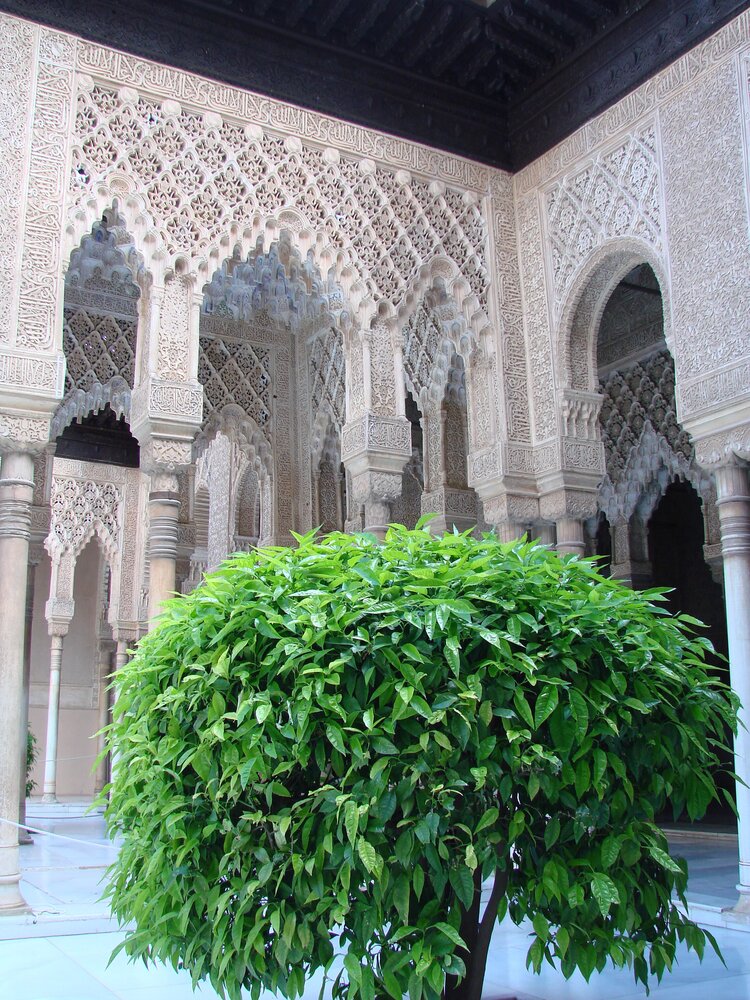
How to get from Granada to the Alhambra
The Alhambra is 1 km from Granada, but the hiking trails pass through hilly terrain. There are 3 routes that can be walked in 15 to 20 minutes along the mountain road:
- Down the slope of Cuesta Gomérez from Plaza Nueva.
- Down the slope of Cuesta del Rey Chico from El paseo de los Tristes street.
- Down the slope of Cuesta del Realejo from Plaza del Realejo.
You can get to the Alhambra by city minibus, route C30. From the Plaza Isabel la Católica stop in the center, it goes all the way to the entrance of the Alhambra.
- A one-way fare is €1.4.
- The mode of operation of the route: from 7.12 to 23:00, daily.
- The traffic interval is 12 minutes.
- Travel time is 10 minutes.
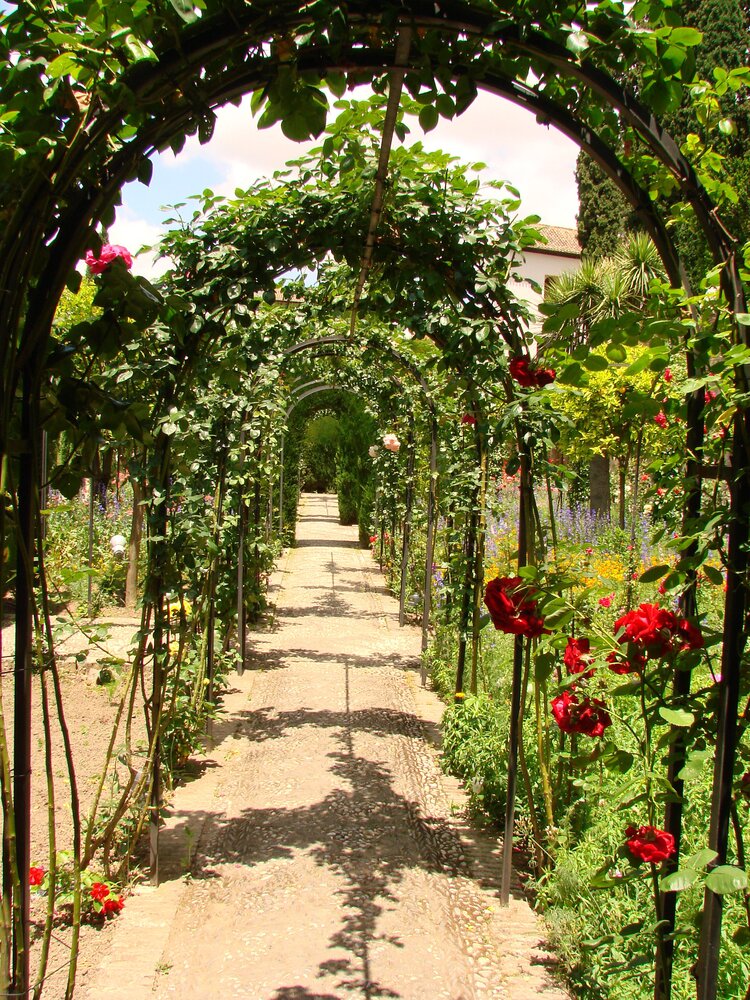
Useful information
- With one of the day tickets to the Alhambra, you can visit the «Room of the Month» (el espacio del mes) for free. Each month, one of the Alhambra’s rooms, which is usually closed because it can’t handle the large number of tourists, is opened to the public. For example, it could be one of the Alhambra’s towers or a room in the palace.
- On the Alhambra’s website, you can buy the«Dobla de Oro General» combination ticket, which includes a visit to the six Andalusian monuments of Granada in the residential neighborhood of Albaycin and all the monuments of the Alhambra. The ticket is valid for three days: one day before visiting the Alhambra and one day after. The price for adults is 19,65 €, children under 12 years old are free.
- There is a 360-car parking lot near the Alhambra.
- The Charles V Palace and the mosque baths (Baño de la Mezquita) are always free of charge.
- It will take at least three hours to see the Alhambra, so I recommend bringing food with you. There are special places for snacks in the complex. You don’t have to bring water — the fountains in the complex have drinking water.
- The best time to visit the complex is at the time of opening — 8:30 or after 14:00. From about 10:00 tourist buses arrive and the number of visitors increases dramatically.
- Even with an online ticket, you have to arrive at the ticket office in advance, half an hour to an hour in advance, to get a place in line.
- When planning your Alhambra itinerary, remember that under the hot Spanish sun you will have to queue at the ticket office and walk around the Alcazaba. Sunscreen and a hat are required for daytime visits. In other parts of the complex, the heat is not terrible: there is plenty of vegetation in the gardens and the palaces are protected by walls and roofs.
- The Alhambra is located in the mountains, so mornings and nights are chilly, even in summer. Take warm clothes with you.
